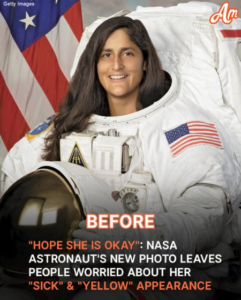New Photo of NASA Astronaut Sunita Williams After Space Mission Sparks Health Concerns
NASA astronaut Sunita Williams has long been admired for her resilience and groundbreaking achievements in space. As one of the most experienced female astronauts, she has spent more than 300 days in space, participating in several missions and spacewalks. However, a recent photograph of Williams after returning from her latest space mission has sparked concerns about her health, with many people questioning the effects of long-duration space travel on the human body.
The Viral Photo That Raised Questions
The image, taken shortly after Williams’ return to Earth, shows her looking noticeably fatigued and physically altered compared to her pre-mission appearance. Fans and experts alike pointed out that her face appeared gaunt, and her posture suggested possible weakness or muscle atrophy—both common effects of prolonged exposure to microgravity.
NASA has yet to release an official statement addressing specific health concerns, but experts emphasize that astronauts undergo extensive rehabilitation upon returning to Earth. The body undergoes significant stress when transitioning back to Earth’s gravity after months in space, and astronauts typically experience muscle loss, bone density reduction, and fluid redistribution, which can give them a swollen or fatigued appearance.
The Effects of Space Travel on Astronauts
Spaceflight takes a toll on the human body, and Sunita Williams’ case is no exception. Scientists have studied astronauts for decades, and some of the most common health challenges they face include:
- Muscle and Bone Loss: In microgravity, astronauts don’t need to use their muscles as much as they do on Earth. As a result, they can lose up to 20% of their muscle mass in just a few months, and bone density decreases, making them more prone to fractures.
- Fluid Shifts: The lack of gravity causes bodily fluids to shift upwards, which can result in facial puffiness and increased pressure on the brain and eyes. Some astronauts experience vision problems even after they return.
- Radiation Exposure: Space travel exposes astronauts to much higher levels of cosmic radiation than they would experience on Earth. Long-term exposure raises concerns about an increased risk of cancer and other radiation-related illnesses.
- Cardiovascular and Immune System Changes: Research has shown that space travel affects the heart’s function and can lead to weakened immune responses, making astronauts more susceptible to infections when they return.
NASA’s Post-Mission Rehabilitation
Given these known risks, NASA has a rigorous post-mission rehabilitation program designed to help astronauts recover. Upon returning to Earth, astronauts undergo weeks or even months of physical therapy to regain their muscle strength, bone density, and balance. They also undergo medical evaluations to monitor any long-term health effects.
Williams, like all astronauts, will be closely monitored in the coming months. Experts believe that with proper care and rehabilitation, she will regain her full strength.
Public Concern and NASA’s Response
While the viral photo of Sunita Williams has raised concerns, experts assure that her condition is expected after space travel and is not necessarily a sign of serious health deterioration. NASA continues to study the effects of long-duration missions, especially as they prepare for upcoming Moon and Mars missions, which will require even longer periods in space.
For now, fans of Sunita Williams can rest assured that she is in capable hands and will continue to be a pioneer in space exploration.


